Assessing Tablet-Sticking Propensity
The authors designed an upper punch with a removable punch tip to determine a tablet formulation's propensity to stick by weighing the mass of powder adhered to the punch tip.
The adherence or sticking of compressed powder to the surfaces of tablet tooling can cause significant drug-product manufacturing problems and quality defects, such as surface picking, surface dulling, and illegible tablet debossing. The literature contains several methods for assessing the degree of punch sticking, including chemical analysis of dissolved material adhered to the punch tip, visual inspection of punch tips, measurement of tablet take-off forces, powder-impingement testing, and measurement of punch pull-off force using an instrumented punch (1–6). Although these methods are useful, simple and quantitative punch-sticking-assessment tools are lacking, and many tablet-formulation scientists have continued to assess the severity of sticking by visually inspecting the tooling surface or the tablet. A reliance on visual inspection represents a significant gap in a formulator's toolbox because the technique is based on subjective opinion, and it is nearly impossible to systematically benchmark sticking behavior with different active ingredients, formulation components, operators, processing conditions, and manufacturing dates.
The authors aimed to design and test a custom tableting punch with a removable tip that would allow users to quantitatively assess material sticking to tooling surfaces by weighing the adhered powder. This approach for measuring the adhered powder has not been put into practice because of the practical difficulties inherent in accurately measuring an extremely small quantity of adhered powder (i.e., micrograms) on a punch that weighs ~100 g. Therefore, a removable punch tip with a low mass (i.e., < 5 g) that can be weighed on a microbalance solves this problem. A simple calculation of the weight of powder adhered to a 12.7-mm diameter flat-faced punch tip suggests that a uniform film thickness as thin as 0.1 µm can be detected using a microbalance, assuming a sample true density of 1.5 g/cc (see Figure 1). This limit of detection is reasonable because the particle diameters of most pharmaceutical powders are greater than 1 µm. In this study, a custom-designed punch with a removable tip was assessed as a method for quantitatively evaluating punch-sticking behavior of formulations containing various concentrations of sticky powders in tablet formulations.
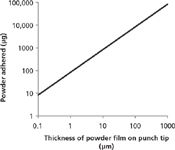
Figure 1: Theoretical calculation of the mass of powder adhered to a punch tip as a function of powder-layer thickness, assuming a 0.5-in., round, flat-faced punch is used and the true density of the adhered layer is 1.5 g/cc.
Materials
Ibuprofen (50 grade, BASF) and mannitol (spray dried, granular, and powder grades, SPI Pharma) were chosen as sticky powders and mixed in glass bottles using a Turbula blender (Quadro Engineering) for 5 min with microcrystalline cellulose (Avicel PH102, FMC Biopolymer) as a common, nonsticky tableting diluent and magnesium stearate (HyQual, Mallinckrodt Baker) as a tableting lubricant. In addition, a prototype formulation containing 50% w/w ibuprofen, 5% w/w talc (IMI Fabi), and other proprietary components was tested alongside commercial ibuprofen blends, including Advil tableting blend (Pfizer), Albermarle ibuprofen 85 (Albe-tab DC85), and BASF ibuprofen (DC85 grade).
Methods
A custom F-type upper punch with a removable tip was designed to be fitted on a single-station laboratory eccentric tablet press (Manesty F3, see Figure 2). The 0.5-in. diameter, round, flat-faced tip was attached to the punch barrel using two set screws in series that seated against the stem of the removable tip. The tip had a mass of approximately 3 g so that it and any accumulated powder could be weighed periodically using a high-precision balance after compressing tablets. The custom upper punch, a standard lower punch, and standard die were installed on the tablet press. The press was operated under power at a rate of 3000 compressions/h to produce 2–3-mm thick tablets with weights of 250 mg and diameter of 12.7 mm at a solid fraction of 0.85. The punch tip was removed, weighed using a microbalance (MT5, Mettler-Toledo), and reinstalled periodically during the compression run.
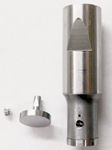
Figure 2: Custom F-type punch with removable tip for tablet punch-sticking assessments, including (left) setscrew, (middle) removable tip, and (right) fully assembled punch.
Results
Effect of ibuprofen loading on sticking. To investigate the sensitivity of the method to various concentrations of a sticky component, different levels of ibuprofen were mixed into a blend containing microcrystalline cellulose and 0.25% magnesium stearate. Figure 3 shows that the sticking propensity and the powder accumulated on the punch tips during the first 100 compressions tested increased with increasing ibuprofen concentrations. The quantitative measurements of accumulated powder were supported by visual inspection of punch tips, which showed high degrees of surface coverage at high ibuprofen concentrations. After approximately 100 compressions, the weight of adhered powder sometimes decreased suddenly or gradually. The sudden decreases in weight were attributed to the detachment of large domains of adhered powder from the punch tip after further compressions. The gradual decreases were attributed to a steady wearing of the film from the punch tip. These results highlight the unpredictable sticking behavior of suboptimal formulations containing high levels of sticky components and emphasize the potential for challenging manufacturing performance.
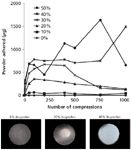
Figure 3: Sticking profiles and representative punch-tip images for blends containing various levels of ibuprofen.
Effect of lubricant level on sticking. The effect of tableting lubricant was studied for blends containing either ibuprofen or spray-dried mannitol with various levels of magnesium stearate. As expected from tableting experience, the spray-dried mannitol had a lower absolute sticking propensity relative to ibuprofen. But, interestingly, opposite trends were observed for the mannitol versus the ibuprofen formulations with various lubricant levels. For the mannitol formulations, increasing proportions of lubricant decreased sticking (see Figure 4). This result suggests that the mannitol had a relatively high affinity for the metal punch surface, which is reduced by lubricant. Conversely, and perhaps counterintuitively, sticking increased for ibuprofen formulations containing high levels of lubricant (see Figure 5). This observation was previously reported using a different sticking assessment method and attributed to the reduction in the interparticle bond strength of ibuprofen and to a eutectic formation between the ibuprofen and magnesium stearate (1). Given these results, this method was able to indicate sticking behavior of sticky formulations as a function of small changes in the level of tableting lubricant.
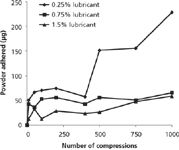
Figure 4: Tablet-sticking profile for 50% w/w spray-dried mannitol blends with various levels of magnesium stearate.
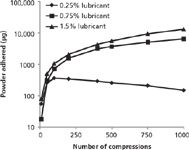
Figure 5: Tablet-sticking profile for 20% wt ibuprofen blends with various levels of magnesium stearate.
Effect of mannitol grade on sticking. The sticking assessment method was also tested to determine whether sticking propensity could be detected using various grades of a single component. Figure 6 shows that after ~10 compressions, the powdered mannitol was about twice as sticky as granular mannitol. As expected, the microcrystalline cellulose did not stick to the punch surface. The higher sticking propensity of the powdered mannitol was hypothesized to result from its higher specific surface area, which increased its bonding potential to itself and the punch surface. A high number of compressions was not investigated with this method because of severe die-wall friction with the unlubricated powders. Mixing the granular mannitol at 75% w/w with microcrystalline cellulose, then further decreasing its concentration to 50% w/w and adding 1% w/w magnesium stearate significantly decreased the sticking propensity of the blend. This result demonstrates that the punch-sticking detection method can guide formulators when they optimize tableting-blend compositions and before progressing to large-scale manufacturing.
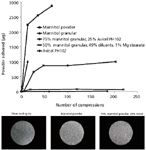
Figure 6: Sticking profiles and representative punch-tip images for blends containing various grades of mannitol and various mannitol formulations.
Benchmarking sticking of a new ibuprofen formulation. A prototype ibuprofen formulation was tested alongside three commercially available ibuprofen formulations to quantify sticking risk before scale-up. The prototype formulation contained a 50% w/w level of ibuprofen and 5% w/w talc as the tableting lubricant. After 100 compressions, the prototype formulation had about 1500 µg of powder adhered to the punch tip. The commercial ibuprofen formulations had lower sticking: Albemarle had the most, followed by BASF and Advil (See Figure 7). Using Advil as the gold-standard benchmark, the prototype formulation was deemed to be unsuitable for product scale-up without reformulation. The high level of sticking for the prototype ibuprofen formulation was attributed to literature reports of talc as a suboptimal tableting lubricant for sticky formulations (7, 8), in addition to ibuprofen's notorious propensity to stick. This quantitative assessment shows the benefit of testing prototype formulations and benchmarking alongside formulations known to (or not to) exhibit sticking behavior. Thus, unsuitable formulations can be flagged quickly during drug product design.
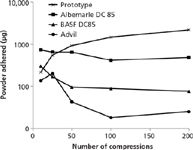
Figure 7: Sticking profiles for prototype and commercially available ibuprofen formulations.
Conclusion
The simple method of using a removable punch tip is capable of quantitatively measuring sticking for formulations containing various levels of tableting lubricant and various grades and concentrations of sticky ingredients. This tool can be used to screen tableting formulations during drug-product design to optimize formulation composition, and potentially to study the effect of sticking on tableting process parameters (e.g., tableting speed and compression force) and tooling design features (e.g., metal composition, surface roughness, shape, curvature, and embossing).
Acknowledgments
The authors thank MDC Associates for assisting with the design and fabrication of the custom punch. They thank Gregory (Scott) Goeken, scientist, and John Kresevic, senior principal scientist, both at Pfizer, for providing the prototype and commercial ibuprofen formulation samples.
References
1. M. Roberts et al., J. Pharm. Pharmacol. 56 (3), 299–305 (2004).
2. T.S. McDermott et al., Powder Technol. 212 (1), 240–252 (2011).
3. D. Simmons, poster at the 12th Annual American Association of Pharmaceutical Scientists—Northeast Regional Discussion Group (Rocky Hill, CT, 2009).
4. J.J. Wang et al., J. Pharm. Sci. 93 (2), 407–417 (2004).
5. Y. Cheng et al., Proceedings of AICHE Annual Conference (Orlando, FL, 2006), pp. 1–13.
6. F. Waimer et al., Pharm. Dev. Technol. 4 (3), 359–367 (1999).
7. M. Bose, A. Sakr, and A. Warner, Pharm. Industrie 55 (5), 519–522 (1993).
8. A. Delacourte et al., Drug Dev. Ind. Pharm. 19 (9), 1047–1060 (1993).
What would you do differently? Email your thoughts about this paper to ptweb@advanstar.com and we may post them on PharmTech.com.
Matthew P. Mullarney* is a principal scientist, Bruce C. MacDonald is a scientist, and Allan Hutchins is a laboratory technician, all at Pfizer, Eastern Point Road, Groton, CT 06340, tel. 860.715.4139, fax 860.441.3972, matthew.p.mullarney@pfizer.com.

Pharmaceutical Tariffs Are Imminent: How Industry is Bracing for Impact
April 16th 2025On April 14, 2025, the Trump Administration launched a national security-driven investigation into pharmaceuticals, a move that will likely result in tariffs being placed on pharmaceutical drugs, ingredients, and other components that are imported from outside of the United States.